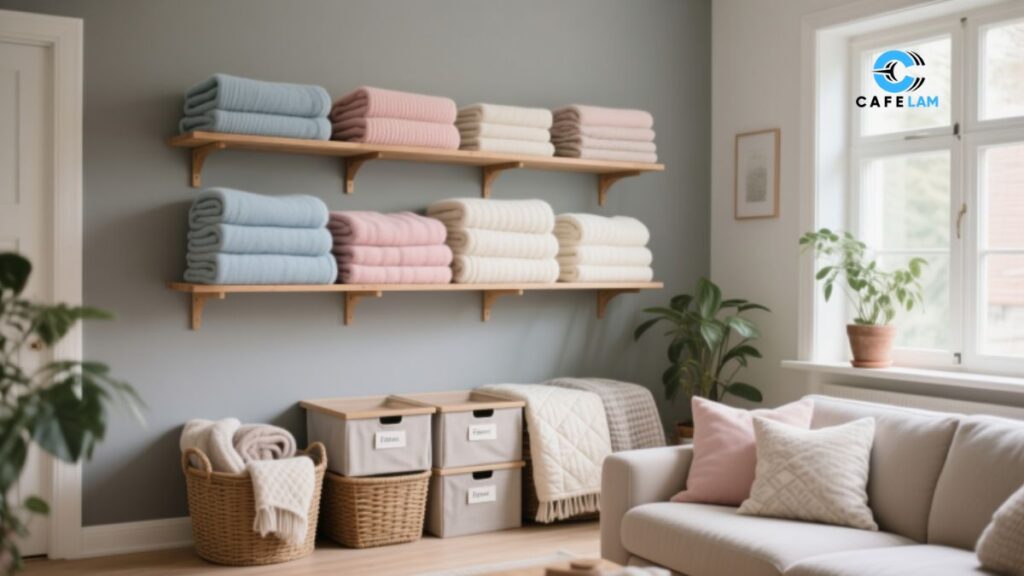Cozy blankets are a staple in almost every home. Whether it’s a soft fleece throw for movie nights, a chunky knit for winter mornings, or a lightweight cotton blanket for summer evenings, these comforting layers add warmth and style to our lives. But as much as we love them, blankets can quickly become a clutter problem if not stored properly. Piles of folded throws on the couch, tangled quilts in the linen closet, or mismatched blankets stuffed into baskets can make even the cleanest home feel disorganized. That’s where smart blanket organization ideas come into play. With a few thoughtful strategies, you can keep your blankets neat, accessible, and even enhance your home’s decor at the same time.
Why Blanket Organization Matters
Cozy blankets are a beloved part of everyday life in most homes. Whether you’re snuggling under a soft fleece throw during a rainy afternoon or layering a quilted comforter on your bed in winter, blankets bring warmth, comfort, and style. But with frequent use and multiple types—throws, quilts, baby blankets, travel wraps—it’s easy for them to pile up and create clutter. Without a solid system, your favorite blankets might end up crumpled at the foot of the couch or buried in a closet corner. That’s where smart blanket organization ideas come in.
Organizing your blankets isn’t just about tidiness—it’s about functionality and peace of mind. When your blankets are neatly stored and easy to access, you’re more likely to use them. You’ll save time searching for the right one, protect your textiles from dust and damage, and even enhance your home’s decor. A well-organized blanket system also makes seasonal switching easier and helps you keep track of what you own. Whether you live in a small apartment or a large family home, effective blanket storage can transform how you experience comfort and order every day.
Start by Sorting Your Blankets
Before diving into storage solutions, take the time to sort through your blanket collection. This simple step is often overlooked but makes a huge difference. Begin by gathering all your blankets from around the house—living room, bedrooms, closets, and even the laundry room. Lay them out in one area so you can see everything at a glance.
Now, start grouping them. Sort by material (such as cotton, wool, fleece, or down), by size (throw, twin, queen), and by season (summer-weight vs. winter-weight). You might also want to separate them by use—everyday throws, guest blankets, baby items, or decorative pieces. As you sort, take note of any blankets that are worn out, stained, or no longer used. These can be donated, repurposed into rags, or recycled if possible. Reducing clutter at this stage ensures that your storage system only holds what you truly need and love.
Baskets: Simple and Stylish Storage
One of the most popular and effective blanket organization ideas is using baskets. They’re versatile, affordable, and blend seamlessly into almost any home decor. Woven seagrass baskets, fabric-lined bins, or even rustic wooden crates can hold folded or rolled blankets while adding texture and warmth to your space.
Place a large basket at the end of your sofa, beside your bed, or in a corner of the living room. This keeps throws within easy reach while preventing them from becoming a messy pile. For a polished look, fold each blanket neatly and stack them vertically or layer them like a display. Choose baskets that match your room’s color palette—neutral tones for a minimalist space, bold weaves for a boho vibe. Baskets are also great for kids’ rooms or nurseries, where accessibility and safety are key.
Blanket Ladders: Functional Decor
If you want your storage to double as a design feature, consider a blanket ladder. These freestanding racks typically have 5 to 7 horizontal rungs and are designed to lean against a wall. They’re perfect for draping folded or rolled blankets in an attractive, accessible way.
Blanket ladders work especially well in bedrooms, living rooms, or even bathrooms. They take up minimal floor space and allow you to showcase your favorite throws like artwork. Choose a ladder made from natural wood for a warm, rustic feel, or go for a sleek metal design in modern interiors. The best part? You can easily switch out blankets with the seasons or whenever you want to refresh the room’s look. Plus, they’re lightweight and portable—move them from room to room as needed.
Ready to take things further? Discover our full library of content.
Wall Shelves for Vertical Storage
When floor space is limited, go vertical. Wall-mounted shelves are a smart solution for blanket organization ideas, especially in smaller homes or apartments. Install a floating shelf above your sofa, bed, or entryway and use it to display folded blankets.
Arrange the blankets in neat stacks, alternating colors or textures for visual interest. Add a small plant, book, or decorative object on the same shelf to break up the look and make it feel intentional. Floating shelves made from reclaimed wood, metal, or glass can match any decor style. This method keeps your blankets visible and within reach while turning storage into a design statement.
Maximize Closet Space
If you have a linen closet or spare closet, it’s an ideal spot for storing multiple blankets. Use shelf dividers to keep stacks from toppling over and maintain order. Fold each blanket uniformly—either in thirds or by rolling them—to create a clean, uniform appearance.
For deeper shelves, use fabric bins or clear plastic containers to group similar items. Label each bin clearly with tags like “Winter Throws,” “Guest Blankets,” or “Baby Swaddles.” This makes it easy to find what you need without disturbing the entire shelf. If you store seasonal blankets, rotate them twice a year—swap out heavy wool ones in summer and bring in lighter cotton or bamboo throws. This keeps your space fresh and functional all year round.
Multi-Purpose Furniture with Hidden Storage
Furniture that doubles as storage is a game-changer for blanket organization ideas. An upholstered bench at the foot of your bed, a storage ottoman in the living room, or a vintage trunk in the hallway can all hide blankets while serving another purpose.
These pieces are perfect for homes where space is tight. Simply lift the lid and store folded blankets inside. Choose a design that complements your decor—perhaps a tufted ottoman for a classic look or a sleek leather trunk for a modern feel. Not only do they keep blankets out of sight, but they also provide extra seating or a surface for decor. In a guest room, a storage bench can hold spare bedding and towels, making it easy to prepare for visitors.
Roll Instead of Fold
Rolling blankets is a clever trick that saves space and prevents deep creases, especially in thick or bulky materials. To roll a blanket, lay it flat, fold it in half lengthwise, and then tightly roll it from one end to the other. Secure it with a fabric tie, ribbon, or elastic band if needed.
Rolled blankets can be stored upright in a basket, bin, or even a large decorative vase. This method works well for beach throws, travel blankets, or lightweight cotton wraps. It’s also a great way to display colorful or patterned blankets as part of your room’s aesthetic. Rolling makes it easier to see and grab what you need, especially in crowded storage areas.
Use Under-Bed Storage
The space under your bed is often wasted, but it’s perfect for storing extra blankets. If your bed frame has enough clearance, use flat, rolling bins or slim storage boxes that slide easily underneath. These are ideal for bulky comforters, seasonal quilts, or rarely used blankets.
Choose clear bins so you can see the contents, or label them clearly with a marker or tag. Some beds even come with built-in drawers—these are a dream for anyone who wants to maximize space without adding extra furniture. Just make sure the blankets are clean and completely dry before storing to prevent musty odors.
Seasonal Rotation and Long-Term Storage
Not all blankets are meant to be used year-round. Seasonal rotation is a smart blanket organization idea that keeps your space uncluttered and your textiles in good condition. Store off-season blankets in vacuum-sealed bags, breathable cotton sacks, or under-bed containers.
For example, pack away heavy wool or flannel blankets in summer and bring out lightweight cotton, linen, or bamboo throws. This prevents overcrowding and protects delicate fabrics from dust, sunlight, and moisture. When storing, always wash and dry blankets first. Avoid plastic bags for natural fibers like wool or down—opt for breathable materials instead. Add cedar blocks or lavender sachets to keep pests away and maintain a fresh scent.
Special Considerations for Kids and Babies
Kids’ rooms and nurseries often have the most blankets—swaddles, crib sheets, play mats, and toddler throws. To keep things organized, use low shelves, labeled bins, or small fabric baskets within reach. Teach older children to put their blankets away after use to build good habits.
For safety, avoid loose blankets in infant cribs—use sleep sacks instead. Store baby blankets in a dedicated drawer or bin labeled by type. Wash them regularly and rotate as your baby grows. A cute basket in the nursery can hold daily-use items, while seasonal or special blankets go into longer-term storage.
Compare the Best Blanket Storage Options
To help you choose the right method, here’s a comparison of popular blanket organization ideas:
|
Baskets
|
Living rooms, bedrooms
|
Low
|
High
|
High
|
|
Blanket Ladders
|
Decorative storage
|
Medium
|
High
|
Very High
|
|
Wall Shelves
|
Small spaces, modern homes
|
Low
|
Medium
|
High
|
|
Linen Closets
|
Multiple blankets, seasonal use
|
High
|
Medium
|
Low to Medium
|
|
Storage Ottomans
|
Multi-functional spaces
|
Medium
|
High
|
High
|
|
Under-Bed Containers
|
Limited space, infrequently used
|
Low
|
Medium
|
Low
|
|
Trunks & Chests
|
Vintage or rustic decor
|
Medium
|
Medium
|
Very High
|
Final Thoughts
Effective blanket organization ideas go beyond just tidying up—they enhance your daily comfort and the overall feel of your home. Whether you prefer the rustic charm of a blanket ladder, the sleekness of under-bed storage, or the simplicity of a woven basket, the right system will make your life easier and your space more inviting. Start small, assess your needs, and choose solutions that match your lifestyle and decor. With a little planning, your blankets can be both beautifully displayed and effortlessly accessible. Embrace the cozy chaos with smart organization, and enjoy a home that’s as warm in order as it is in spirit.
FAQs
Q: How many blankets should I keep?
A: There’s no fixed number, but a good rule of thumb is to keep what you actually use. Most households only need 1–2 throws per seating area, 1–2 sets of bedding per bed, and a few extras for guests. If you’re storing more than that, consider donating unused ones.
Q: Can I store blankets in vacuum bags?
A: Yes, for long-term storage of off-season blankets, vacuum-sealed bags are excellent for saving space. However, avoid using them for wool, down, or other delicate fabrics that need to breathe. Use them mainly for synthetic or cotton blankets.
Q: Where should I store guest blankets?
A: The best places are a hall closet, linen closet, or a decorative basket in the guest room. Make sure they’re clean, folded neatly, and easy to access. Adding a small note or tag like “For Guests” can be a nice touch.
Q: How do I prevent my blankets from getting musty?
A: Always store clean, dry blankets in a cool, dry place. Use breathable storage containers for natural fibers and add moisture absorbers or cedar blocks to prevent dampness and pests.
Q: What’s the best way to organize baby blankets?
A: Use small bins or drawers labeled by use—swaddles, burp cloths, play mats. Keep them in the nursery or changing area for quick access. Wash them regularly and rotate as your baby grows.
Q: Can I use furniture for blanket storage?
A: Absolutely! Storage ottomans, benches, trunks, and even coffee tables with hidden compartments are great for holding blankets. They save space and add functionality to your decor.







